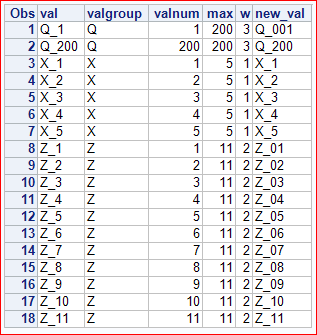- Home
- /
- Programming
- /
- SAS Procedures
- /
- Add leading zero based on the number of numbers for that value
- RSS Feed
- Mark Topic as New
- Mark Topic as Read
- Float this Topic for Current User
- Bookmark
- Subscribe
- Mute
- Printer Friendly Page
- Mark as New
- Bookmark
- Subscribe
- Mute
- RSS Feed
- Permalink
- Report Inappropriate Content
Hello,
I have a situation where I have data like this
X_1
X_2
X_3
X_4
X_5
Z_1
Z_2
Z_3
Z_4
Z_5
Z_6
Z_7
Z_8
Z_9
Z_10
Z_11Where the data has a value over 9 I need 1-9 to have a leading zero. Based on the above data I need this to happen
X_1
X_2
X_3
X_4
X_5
Z_01
Z_02
Z_03
Z_04
Z_05
Z_06
Z_07
Z_08
Z_09
Z_10
Z_11Here is the code I'm starting to work with. This column of data can have values with no '_' or and '_' with characters after. I only want to do this for values where there are numbers after the '_'.
data x ;
set temp ;
start = scan(val, 1, '_') ;
end = scan(val, 2, '_') ;
if end ne '' and ANYALPHA(end) = 0 then output ;
run ;Thank you for any help you can give me.
Accepted Solutions
- Mark as New
- Bookmark
- Subscribe
- Mute
- RSS Feed
- Permalink
- Report Inappropriate Content
You have to find the W(idth) for each VAL group X and Z. Then you can creat the VAL with the proper number of leading zeros.
data val;
input val:$8.;
cards;
X_1
X_4
X_5
Z_1
Z_2
Z_6
Z_7
Z_8
Z_9
Z_10
Z_11
X_2
X_3
Z_3
Z_4
Z_5
Q_1
Q_200
;;;;
run;
data valv / view=valv;
set val;
length valgroup $32;
valgroup = scan(val,1,'_');
valnum = input(scan(val,-1,'_'),8.);
run;
proc sort data=valv out=val2;
by valgroup valnum;
run;
proc print;
run;
proc summary data=val2;
by valgroup;
output out=max(drop=_:) max(valnum)=max;
run;
data val3;
merge val2 max;
by valgroup;
w = floor(log10(max)+1);
length new_val $10;
new_val = catx('_',valgroup,putn(valnum,'Z',w));
run;
proc print;
run;

- Mark as New
- Bookmark
- Subscribe
- Mute
- RSS Feed
- Permalink
- Report Inappropriate Content
You have to find the W(idth) for each VAL group X and Z. Then you can creat the VAL with the proper number of leading zeros.
data val;
input val:$8.;
cards;
X_1
X_4
X_5
Z_1
Z_2
Z_6
Z_7
Z_8
Z_9
Z_10
Z_11
X_2
X_3
Z_3
Z_4
Z_5
Q_1
Q_200
;;;;
run;
data valv / view=valv;
set val;
length valgroup $32;
valgroup = scan(val,1,'_');
valnum = input(scan(val,-1,'_'),8.);
run;
proc sort data=valv out=val2;
by valgroup valnum;
run;
proc print;
run;
proc summary data=val2;
by valgroup;
output out=max(drop=_:) max(valnum)=max;
run;
data val3;
merge val2 max;
by valgroup;
w = floor(log10(max)+1);
length new_val $10;
new_val = catx('_',valgroup,putn(valnum,'Z',w));
run;
proc print;
run;

- Mark as New
- Bookmark
- Subscribe
- Mute
- RSS Feed
- Permalink
- Report Inappropriate Content
data have;
input x $;
cards;
X_1
X_2
X_3
X_4
X_5
Z_1
Z_2
Z_3
Z_4
Z_5
Z_6
Z_7
Z_8
Z_9
Z_10
Z_11
;
data want;
set have;
x=ifc(index(x,'Z')>0, catx('_',scan(x,1,'_'),put(input(scan(x,2,'_'),2.),z2.)),x);
run;
- Mark as New
- Bookmark
- Subscribe
- Mute
- RSS Feed
- Permalink
- Report Inappropriate Content
You've received some great options from @data_null__ and @slchen. I don't have a better way, but I'll offer this: I think you should consider using leading 0s for ALL of your values, not just those that exceed a 1-digit length. I think you'll find the consistency is better for sorting and reporting. I don't know the context of your application here, but what if today you have X_1 - X_5, but tomorrow your Xs grow to X_11? The consistency and predictability of the values might help you in the long run.
- Mark as New
- Bookmark
- Subscribe
- Mute
- RSS Feed
- Permalink
- Report Inappropriate Content
April 27 – 30 | Gaylord Texan | Grapevine, Texas
Registration is open
Walk in ready to learn. Walk out ready to deliver. This is the data and AI conference you can't afford to miss.
Register now and lock in 2025 pricing—just $495!
Learn the difference between classical and Bayesian statistical approaches and see a few PROC examples to perform Bayesian analysis in this video.
Find more tutorials on the SAS Users YouTube channel.
SAS Training: Just a Click Away
Ready to level-up your skills? Choose your own adventure.



